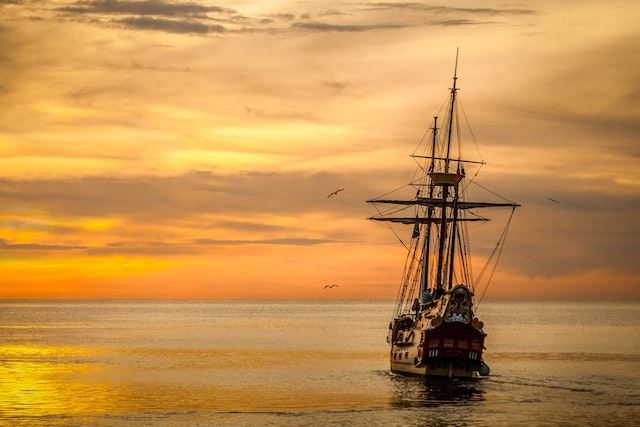
What was the Royal African Company? It was a British slaving company that ties the British royal family to the slave trade.
Britain started kidnapping African people as slaves in 1562. It didn’t start out as a national policy, but it quickly became one. John Hawkins is credited as being the “pioneer of the English slave trade,” which is a pretty awful name to have. He had heard that there was money to be made selling slaves from the west coast of Africa and selling them in the Spanish Caribbean colonies. The Portuguese had started doing this in 1526. They bought slaves from West African traders and transported them to their colony in Brazil. John Hawkins heard about this trade and he put together a syndicate where he split the costs with four other people. He sailed to Africa, captured about 300 people, and sailed to the Caribbean and traded them for pearls, hides, and sugar. He made such a significant profit that Queen Elizabeth I wanted to get in on the action and connected the royal family to the slave trade.
Over the next 80 years, the number of colonies in the Americas increased. Many of the colonies in the Caribbean were used to grow sugar and tobacco and cotton were grown in the American colonies. A triangular trade arose across the Atlantic. Slaves were taken from Africa to the Americas. The slaves were traded for sugar, tobacco, and cotton, which was shipped to Europe where it was traded for textiles, rum, and other goods, which were shipped to Africa where they were traded for slaves.
In 1660, King Charles II of England granted a royal charter to the Company of Royal Adventurers Trading into Africa to trade in gold out of West Africa. In 1663, the charter was amended to include slaves. The charter gave the company a monopoly on all slaves traded out of Africa. The reason for this was twofold. The first reason was that Charles II wanted to cut into the Dutch slave trade that was becoming dominant in the area. The second reason was that with less competition, more of the profits would go to Charles II, who was desperately in need of money.
Charles II was succeeded by his brother, James II, who invested even more in the Company. During one year of James’s reign, 38 ships sailed from Africa to trade slaves. James also sent Richard Holmes, a mercenary, to West Africa to claim the coast for England. The Dutch who were present in the area conceded without a fight. The Company of Royal Adventurers Trading in Africa moved into the area and started to build secure forts and open up trade routes to the interior of the country. The Company would take possession of metals, ivory, hides, pepper, and slaves that came out of central Africa. They would store them in their forts, which were located on the coast, until ships arrived. They would trade their goods and the ships would sail away. In 1665, about one quarter of their profits came from slaves.
As the plantations started to become more prosperous, there was a need for more labor. The plantation owners didn’t want to lose money by paying people, so they opted for slaves and the slave trade increased rapidly. Between its founding in 1662 and 1672, the Company of Royal Adventurers transported 26,925 slaves from Africa to the Americas. 6,620 of these people died on the journey. This was seen as an acceptable loss. The slaves were treated as merchandise and not people. In fact, they were treated worse than merchandise because no trader would be happy if a fifth of his stock was ruined in transport.
In 1672, the Company of Royal Adventurers went bankrupt. This was due to huge losses they incurred during the Second Anglo-Dutch War and they lost their charter. They were unable to trade in slaves. That is until they rebranded as the Royal African Company and rebranded. Their charter came from Charles II again, but the Duke of York, who would become James II, was their biggest supporter and shareholder. The company increased in strength and built more forts along the West Coast of Africa and increased its trade in slaves. Between 1672 and 1731, they transported 187,687 slaves and 38,497 of them died on the way. It is impossible to put the inhumanity of that into words.
The company lost its royal charter when James II was deposed in 1688. William III, his successor still had shares in the company, but they lost their monopoly. They carried on trading, but found the competition too hard. They stopped trading in slaves in 1731 and they were disbanded in 1752.
Britain continued with the slave trade until 1807 and it is estimated that they transported 3.1 million Africans. A staggering 400,000 of these people died on the way. The Royal African Country may only have been a small part of that, but they were instrumental in making it the enormous trade that it was and they were eagerly supported by the monarchs of England who wanted to make some money. And this is what I learned today.
Sources
https://www.npg.org.uk/learning/digital/history/abolition-of-slavery/the-slave-trade
https://en.wikipedia.org/wiki/John_Hawkins_(naval_commander)
https://en.wikipedia.org/wiki/Atlantic_slave_trade
https://en.wikipedia.org/wiki/Triangular_trade
https://www.pbs.org/wgbh/aia/part1/1p269.html
https://en.wikipedia.org/wiki/Royal_African_Company
https://www.history.com/news/what-was-the-royal-african-company
https://www.pepysdiary.com/encyclopedia/7105/
https://www.discoveringbristol.org.uk/slavery/routes/places-involved/britain/british-law/
https://www.slavevoyages.org/voyage/database/

[…] up to take advantage of the trade and to offset the risk by having a large number of backers. These companies became enormous and had their own armies. They were able to control entire countries. The […]